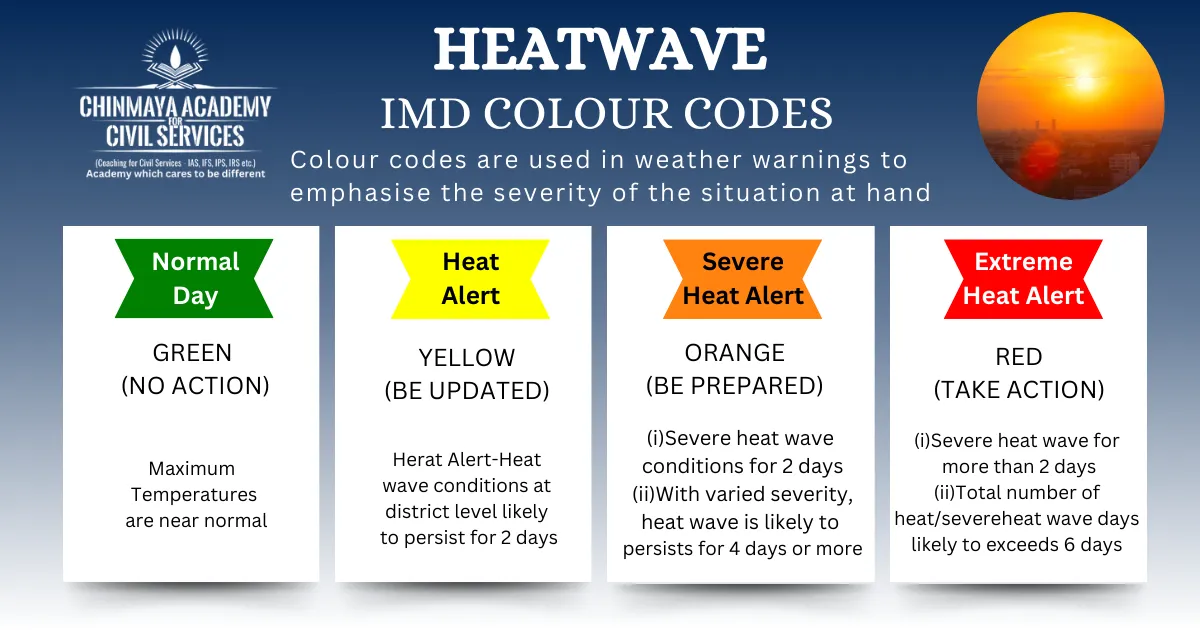
- A heat wave is a high temperature condition that can be lethal to the human body.
- Quantitatively, it is characterised by temperature thresholds over a region in terms of actual temperature or deviation from normal.
Criterion for declaring heat wave
- A heat wave is defined as a maximum temperature of at least 40 degrees Celsius in plains and at least 30 degrees Celsius in hilly regions.
- Departure from average for heat waves ranges from 4.50 to 6.40 degrees Celsius.
- Severe Heat Wave: >6.40C deviation from the normal
- Heat Wave Based on Actual Maximum Temperature: When actual maximum temperature is greater than 450 C
- When the real maximum temperature is greater than 470 degrees Celsius, it is considered a severe heat wave.
- If the foregoing criteria are met at least twice in two stations in a Meteorological sub-division over two consecutive days and declared on the second day.
- For coastal areas, a heat wave can be described when the highest temperature deviates by 4.5 degrees Celsius or more from normal, assuming the actual maximum temperature is 37 degrees Celsius or higher.
Favorable conditions for Heat wave
- Transportation / Prevalence of hot dry air over a region (There should be a region of warm dry air and an adequate flow pattern to transport hot air over it).
- Lack of moisture in the upper atmosphere (because moisture prevents temperature increases).
- To provide the greatest amount of insulation for the area, the sky should be nearly cloudless.
- Anti-cyclonic flow with large amplitude across the region.
- The heat wave over India peaks in May, but it usually occurs from March to June and, in exceptional occasions, even in July.
Consequences
- The loss of human life
- Decreased work productivity
- Increased out-of-pocket healthcare expenses
- Crop losses in agriculture
- prone to illnesses linked to the heat, such as heart disease, mental disorders, Inadequate blood flow and sunburn
Mitigation
- Increasing green cover: Urban forests should be expanded, and greening could help reduce heat waves.
- Wetlands: It is necessary to preserve and expand the wetlands.
- Water bodies – It is critical to restore dead and deteriorating ponds and lakes.
- Reduce the use of preamble materials in residential and public infrastructure projects to lessen the urban heat island effect.
- Improving urban areas’ natural landscapes will also help to mitigate the effect.
- Urban building codes should be updated to avoid the use of heat-absorbing galvanised iron and metal roof sheets.
- Cleaner cooking fuels can help mitigate urban heat by lowering indoor air pollution.
- Natural vegetation: With the poor ventilation, it is possible to increase it in the streets.
- Using public transit can help to minimise the excessive heat and reduce pollution.
Landfill management: Methane-containing landfill fires can be prevented by promoting waste segregation and solid waste management at the source.
The ability to forecast should be expanded to take into account the effects of intense heat on food production.
 Chinmaya IAS Academy – Current Affairs Chinmaya IAS Academy – Current Affairs
Chinmaya IAS Academy – Current Affairs Chinmaya IAS Academy – Current Affairs
